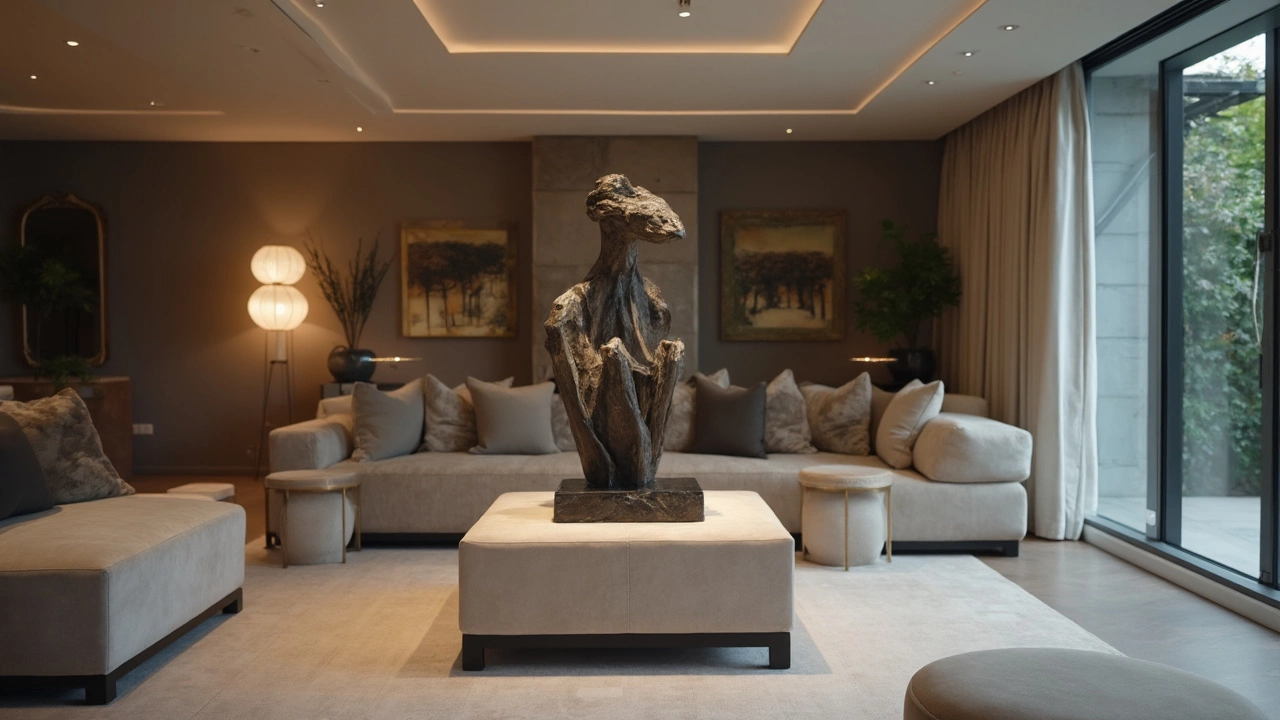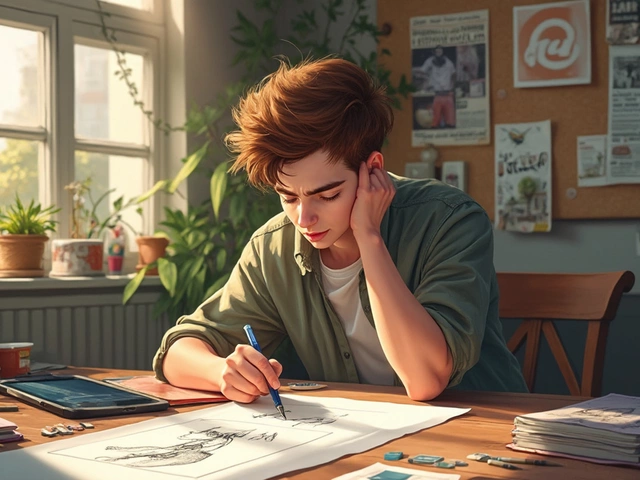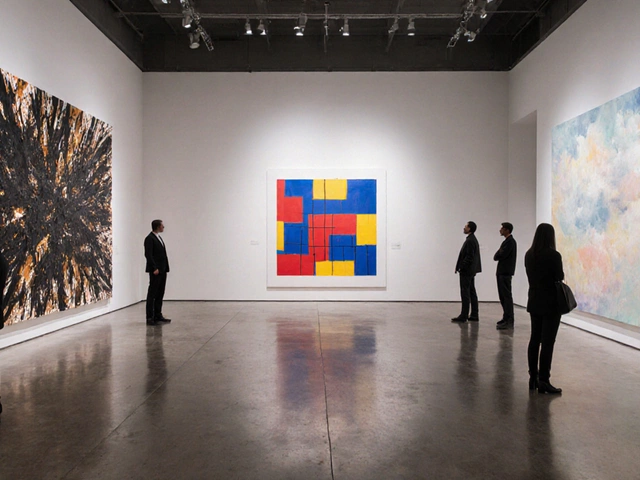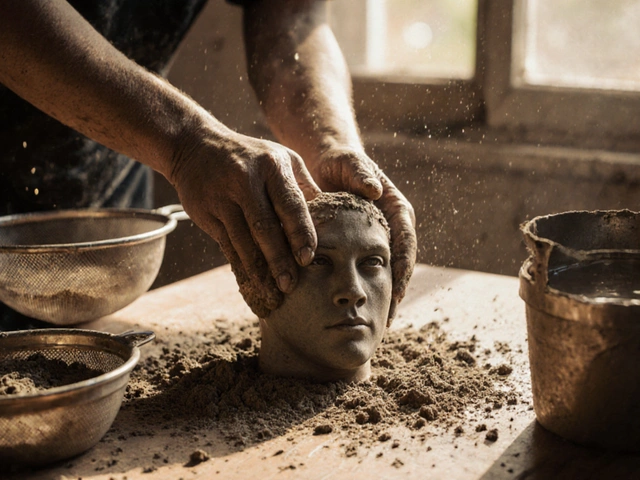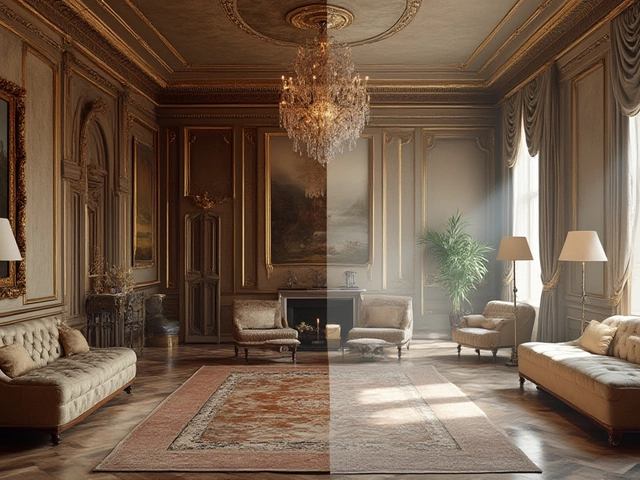Ever noticed how a sculpture can look completely different in another spot? That's not an accident. Where you put a sculpture and how you light it will totally change the way people see and feel about it. There’s no magic formula—getting it right takes a mix of common sense, a bit of planning, and sometimes a willingness to move things around until you nail it.
The first thing most people forget: eye level matters. Place a small sculpture on a high shelf, and you’ll just get a view of the top. Drop a heavy bronze on the floor, and people end up craning their necks or stepping over it. Think about how folks naturally look at things. Even top museums will experiment with different heights before settling on one.
Lighting isn't just about making your sculpture visible. The right light can make shadows dance, bring out textures, and give your piece a totally different mood. A study at the Museum of Modern Art found that changing from overhead lighting to angled spotlighting made even classic marble statues look more ‘alive’—just by shifting the shadows.
- Why Placement is Everything
- How Light Transforms Sculpture
- Common Display Mistakes (And Fixes)
- Choosing the Right Stand or Base
- How Space and Scale Change the Game
- Tips for Home and Gallery Displays
Why Placement is Everything
So, you’ve got a killer sculpture. But if you plop it in the wrong spot, nobody’s going to notice it. Art placement is the first thing you should think about, because even the greatest work can lose its punch if it’s shoved in a corner or too high on a shelf.
Let’s make it simple: Placement controls what the viewer sees first, how close they get, and even how they move around the piece. For example, the Louvre didn’t stick the Venus de Milo in a side hallway—they put her in a main space where she draws you in and holds attention. It’s site selection 101.
Now, there are a few facts you should know. Human eye level averages between 57 to 60 inches off the ground. Most galleries use that as their “center line”—so for tabletop sculptures, you want the main focal point right near that line. If it’s too high or low, you’re going to lose impact. As a tip, place the main detail of the sculpture close to where people’s eyes naturally rest, especially if it’s the part you really want them to notice.
Check this advice from the Association of Art Museum Directors:
"Where you place art isn’t only about room size—it’s about the conversation you start between the viewer and the piece. Good placement lets people discover, linger, and connect."
Here are a couple practical things to think about before you settle on a spot for your sculpture display:
- Traffic flow: Is the piece in the path where people walk, or tucked away where it’s missed?
- Viewpoint: Can you walk all the way around it, or is it flat-back and meant for one side?
- Background: Wild patterns or flashy colors can distract from the actual sculpture. Neutral or plain walls are usually your best bet.
- Distance: Are people able to get close, or is it blocked off or out of reach?
Fun fact: When the British Museum repositioned their ‘Hoa Hakananai’a’ statue, visitor traffic to that gallery jumped by 20%. Placement did what marketing couldn’t.
Bottom line? Where you put your sculpture shapes how people see it, how long they stay with it, and whether they remember it three hours later. It’s not just setting it down—it’s giving your art a stage.
How Light Transforms Sculpture
Lighting totally changes how a sculpture display feels. A sculpture sitting in a dark corner? It’ll probably get ignored. But put it under a clear spotlight, and suddenly every curve, edge, and detail starts to pop. Most folks don’t realize just how much the right—or wrong—lighting can set the mood and show off the sculptor’s hard work.
There’s actually a lot of science behind how we see shapes. Strong, angled light can highlight texture, making something as simple as clay look complex and dramatic. Museums often use filters and angled lamps to bring out hidden details. Think about Michaelangelo’s David in Florence—staff use high, directional light to show muscle definition, so even fine veins look realistic. It’s not just about brightness either, but also the color and warmth of the bulbs. Warm light makes bronze glow, while cool light makes marble feel smooth and chill.
If you’re setting up your own sculpture display at home or in a gallery, try out a few things and see what works best:
- Use spotlights for dramatic effect, especially with textured pieces.
- Soft, diffused lighting can make metal or glass sculptures less harsh on the eyes.
- Try moving the light source around—a side light brings out texture, while light from above can flatten details.
- Natural sunlight works great, but UV can damage some materials over time, so watch out.
- Think about shadows. Sometimes the shadow is almost as interesting as the piece itself.
Check out this quick breakdown of lighting types and their effects:
| Lighting Type | Best For | Effect |
|---|---|---|
| Spotlight (angled) | Stone, bronze, textured surfaces | Dramatic shadows, highlights detail |
| Diffuse (soft) | Glass, polished metal | Smooths surfaces, reduces glare |
| Natural daylight | Most media, but watch fading | Bright, honest color rendering |
One overlooked trick? Take a photo from different angles and see which lighting makes the sculpture display stand out. Even pros do test shots before a big exhibition because what looks good in person can fall flat in photos. Experiment, and don’t be afraid to rearrange lights until the sculpture looks just right.
Common Display Mistakes (And Fixes)
Plenty of folks mess up when they're setting up a sculpture display. The good news is, almost every mistake can be fixed with some easy changes. Let's break down the usual slip-ups and how to make them right.
- Bad Lighting: One of the biggest blunders is lighting a sculpture from overhead or, worse, from the back. A shadowy or washed-out piece loses detail, especially for marble or wood. Use directional lighting from the front or side for dramatic shadows that highlight the texture. If your budget allows, get an adjustable spotlight—you can move it around until your piece looks its best.
- Wrong Height: Museums know that placing artwork at eye level is key. The "60-inch rule" (centering art 60 inches above the floor) works for paintings, but with sculpture art you need to measure things out. Too high or too low, and viewers miss the details. Test different stands or platforms before thinking it's "done."
- Cluttered Background: Displaying your sculpture with a busy backdrop makes it impossible to focus. If the wall or area behind your piece is full of color, pattern, or stuff, try a simple, solid background. Even a blank white wall will give your sculpture display more breathing space.
- Too Little Room: People like to walk around, get up close, or step back. Jamming your piece in a tight corner or against the wall shuts down that kind of interaction. Make sure viewers can see all sides by clearing at least a foot or two around it.
- No Security: If your sculpture is light, top-heavy, or fragile, anchoring it can save you a world of pain. A wobbly sculpture is an accident waiting to happen, especially in a home with kids or pets.
To show you how these fixes stack up, here's a quick table comparing common mistakes with the best solutions:
| Mistake | Quick Fix |
|---|---|
| Overhead/bad lighting | Move lamp to side; try a spotlight angled at 30° |
| Wrong height | Raise on a plinth or lower to eye level |
| Cluttered background | Use plain, single-color wall or backdrop |
| No space around piece | Clear at least 12" on all sides |
| Unstable base | Use proper stand and anchor securely |
Fixing display mistakes often doesn't cost much. Try a few tweaks, and your sculpture display will instantly look more professional—whether it's in a gallery or on your bookshelf.
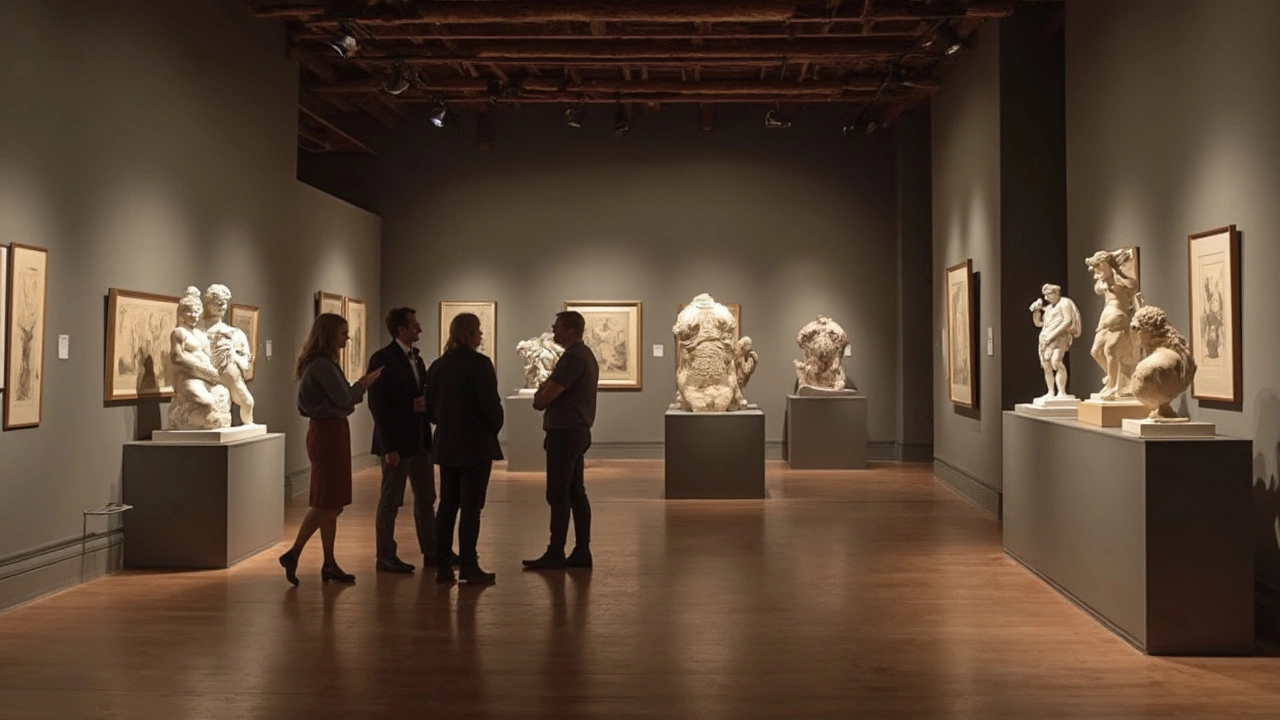
Choosing the Right Stand or Base
Picking the perfect stand or base makes a huge difference when you’re setting up any kind of sculpture display. That stand does more than just hold the piece at the right height—it actually changes how people see the work and, believe it or not, can even affect its safety. Think about it: a wobbly, cheap-looking pedestal under a valuable bronze instantly distracts from the art and can be risky if bumped.
A good rule of thumb is that the size of the base should match the footprint of the sculpture. You want it wide enough to keep everything stable, but not so big that it’s taking attention away from the art itself. Most galleries use bases that stick out about two inches on each side—just enough for stability but not so much that the base starts to compete visually with the sculpture.
Material matters too. Industrial-looking steel might feel right at home with modern, abstract art, but probably clashes with something soft like carved wood or delicate ceramics. For classic works, neutral painted wood or stone almost always works. A base that’s too glossy can create weird reflections, especially under bright lighting. Go with matte or satin finishes to keep the focus on the actual piece.
Got a heavy sculpture? Don’t just hope for the best—know the weight limits. Most standard gallery pedestals can handle 100-200 pounds, but always double-check if the sculpture is massive (think concrete, bronze, or an awkward shape that puts lots of pressure on one point). Here’s a quick drill-down, just so there’s no guesswork:
| Base Material | Max Weight (lbs) | Best For |
|---|---|---|
| Painted Wood | ~150 | Ceramics, Small Bronzes |
| Metal | ~300+ | Heavy Stone, Large Bronze |
| Acrylic | ~75 | Lightweight Modern Pieces |
Height is another call you’ll want to get right. The goal with most art placement is to get the focal point of the sculpture at average eye-level—usually about 57 to 60 inches from the floor. If it’s a tall, vertical work, a lower stand keeps it from looming. If it’s small or detailed, a taller base helps draw people in to take a closer look.
Quick tips to get your base just right:
- Test out a few different heights using boxes or old furniture before buying a proper stand.
- Secure wobbly sculptures with museum putty for extra stability—trust me, you’ll sleep better.
- Stick with colors that either blend with your wall or just disappear—white, black, or light gray do the trick in most homes and galleries.
Turns out, a little thinking about bases goes a long way. The right pedestal isn’t just a place to set your sculpture—it's a partner in making sure your viewer experience is a good one.
How Space and Scale Change the Game
Picking the right spot for your sculpture display is just half the challenge—the actual size of your artwork and the room around it will decide if it feels like a showstopper or an afterthought. Ever seen a tiny figurine thrown into a giant empty lobby? It gets lost, no matter how beautiful it is. On the other hand, drop a massive steel piece into a small living room and suddenly, people can't walk around it or see it from different angles. It’s all about balance.
Scale affects more than just looks; it changes how people experience your art. For example, Richard Serra’s huge steel sculptures at the Guggenheim Bilbao force you to walk around them and get a little lost—it’s part of the fun. Meanwhile, tabletop sculptures can invite a close-up, hands-on look (just watch out for sticky fingers at home!).
Think about the math, too. Gallery pros usually recommend allowing at least 2 to 4 feet of empty space around a medium-sized piece, so folks can move around and see all sides. Too cramped? People skip by or miss parts. Too much distance? Your sculpture can feel lonely, like it’s not part of the room. Here's a quick table to help match sculpture size to recommended space:
| Sculpture Size | Recommended Clearance |
|---|---|
| Small (under 12 inches) | 12-18 inches |
| Medium (1-3 feet) | 2-4 feet |
| Large (over 4 feet) | 4-6+ feet |
This isn’t rigid, but keep it as a rough guide. And don’t forget the viewer experience: people like space to step back and see the whole thing, but they also want to come closer to check out the details. Test different spots if you can, and see where your sculpture art feels most comfortable—in your eyes, and for everyone who’s going to enjoy it.
One more no-nonsense tip: be careful around doorways, walkways, and busy zones. More than a few famous pieces have been knocked over by someone not watching where they’re going. Plan for traffic, and your sculpture stays safe and gets seen the way you want.
Tips for Home and Gallery Displays
Displaying a sculpture at home isn’t just about finding an empty spot. You want the piece to actually stand out, not just collect dust in the corner. For smaller pieces, a clear space on a side table or a dedicated pedestal at eye level makes a world of difference. Avoid window ledges—sunlight can fade finishes over time, especially on wooden or painted sculptures. If you’ve got pets or kids, pick a spot that’s out of their way or use weights to anchor the base.
In galleries or more public spaces, traffic flow is a big deal. Place sculptures where people naturally pause, like at hallway intersections or in the center of a room. It sounds obvious, but avoid crowding art—museums like the Louvre and MoMA often leave at least a meter around freestanding pieces, so viewers get the full 360-degree experience. If you want more people to interact with your sculpture display, place it somewhere folks can actually walk around it, not just face it head-on.
Good lighting is a total gamechanger. For homes, LED spotlights work great because they give off little heat and you can adjust them to highlight textures. For galleries, team up angled overhead lights with portable spotlights to chase away ugly shadows. A survey by the American Alliance of Museums said 68% of curators adjust lighting at least twice before settling on the final setup—so don’t be afraid to experiment.
- Keep the base simple—let the sculpture shine, not the stand.
- Dust often, especially for textured or rough surfaces.
- Reflective surfaces behind a sculpture can double the visual impact, but avoid busy backgrounds that steal attention.
- When moving sculptures, use gloves. Oils from your skin can stain metal or stone over time.
Here’s a handy table comparing what works best for home vs. gallery sculpture displays:
| Factor | Home | Gallery |
|---|---|---|
| Lighting | LED spotlights, window light (with care) | Adjustable overhead, spotlights |
| Placement | Eye-level, safe from pets/kids | Central or walkway intersections, ample space |
| Traffic | Low (family/friends) | High (visitors, events) |
| Maintenance | Occasional dusting | Regular professional cleaning |
Try switching up your sculpture art every few months to keep things feeling fresh. It’s all about making sure your piece grabs attention, feels intentional, and earns those second glances.
